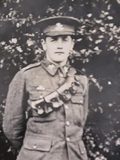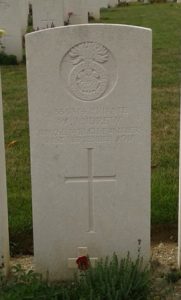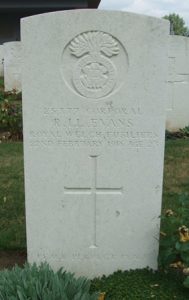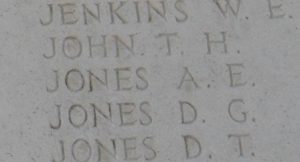Manafon is a small rural community located in the hills of Montgomeryshire, about eight miles from Welshpool, in the valley of the River Rhiew. The community consists of two villages: Manafon and New Mills, and includes a number of scattered farms and hamlets. The men of the community who fell during both World Wars are commemorated on memorial, in the form of a Celtic Cross, which is situated within the grounds of St. Michael’s Church. Unfortunately I have failed to identify the two people who fell during World War Two, so any details would be most welcome.
The Great War, 1914-1918
Walter Andrew, Private, 355314, Royal Welsh Fusiliers. Walter was the son of Richard Andrew and Martha Andrew (nee Webster), of Cefn New Mills, Manafon. He enlisted at Welshpool into the 1st Battalion, Montgomeryshire Yeomanry on 9 October 1914. The regiment had been mobilised at Welshpool on 5 August 1914, as part of the South Wales Mounted Brigade, before moving via Hereford to Thetford, to join the 1st Mounted Division, and Walter joined the regiment there. On 4 March 1916 the 1st Mounted Division sailed for Egypt to join the EEF and spent the coming months guarding the Suez Canal, and taking part in the campaign against the Senussi. On 4 March 1917 the battalion merged with the Welsh Horse Yeomanry to form the 25th (Montgomery & Welsh Horse Yeomanry) Battalion, Royal Welsh Fusiliers, as part of the newly formed 231 Brigade, 74th (Yeomanry) Division. The Division had formed in Egypt in January 1917 and had fought through the Palestinian Campaign, at the Battles of Gaza and the Battle and capture of Jerusalem. Due to the terrible casualties suffered by the British on the Western Front in March and April 1918 the Division was recalled to the Western Front, and arrived at Marseilles during May 1918. The Division trained near Le Cauroy before taking over positions in the St. Floris Sector, moving into the front line between the La Bassée Canal and the River Lys, with the left resting on the small village of Corbie. The Division faced the recently lost town of Merville, some 3,000 yards away. To the south, the Allies launched their offensive on 21 August 1918, and began the great advance towards the Hindenburg Line. The 74th Division was transferred south to join the offensive and assembled around Beaucourt Chateau, before moving forward to the battle area, to take part in an assault near Ronssoy upon the outer Hindenburg Line defences, centred around Gillemont Farm. Walter was killed in action during the main assault on 21 September 1918. The 22-year-old was originally buried on the battlefield, but after the Armistice the area was cleared, and his grave was re-interred to Templeux-Le-Guerard British Cemetery, France. The photos below are courtesy of Glyn and Gwen Buckley.


Joseph Evans, Private, 55202, Royal Welsh Fusiliers. Joseph was the fifth son of Thomas and Emily Jane Evans, of Lower Glyn, Manafon. He was a farm worker prior to the war. Joseph enlisted into the Montgomeryshire Yeomanry at Welshpool, and was posted with the reserve units to Oswestry for training. He was posted to France in the Spring of 1917, joining the 2nd Battalion, Royal Welsh Fusiliers, which was attached to 19 Brigade, 33rd Division. The Division saw heavy fighting during the Battle of Arras during the Spring, with the 2nd RWF suffering heavy casualties during a series of assaults upon the Hindenburg Line. The Division moved to Bray Dunes, on the coast, by 1 August 1917, in readiness for an offensive, but following the stagnation of the Passchendaele offensive, was moved to the Ypres Salient in September and took part in a costly assault at Polygon Wood on 26 September. The Division took part in further fighting on Passchendaele Ridge before wintering in the Salient. On 6 February 1918 the 2nd RWF transferred to 115 Brigade, 38th (Welsh) Division. After the Germans launched their offensive on the Somme on 21 March 1918, the Division was moved back to the Somme, and took up positions north of Albert, at Bouzincourt, and soon afterwards the 2nd RWF took part in an assault to clear the Germans from the heights of Bouzincourt Ridge. On 21 August 1918 the Allies launched their great offensive, and the 38th Division crossed the Ancre Valley before capturing Thiepval Ridge and Pozieres. The Division then advanced across the old Somme battlefields, clearing Mametz Wood, High Wood and Delville Wood over the coming days. On 28 August the Division took part in an assault on Morval, before the men dug into a new line in front of Lesboeufs. Joseph was killed here by German artillery fire on 30 August 1918. The 22-year-old is buried in Guards’ Cemetery, Lesboeufs, France. He was the second of three brothers to be killed during the war.
Robert Llewelyn Evans, Corporal, 25377, Royal Welsh Fusiliers. Robert was the fourth son of Thomas and Emily Jane Evans, of Lower Glyn, Manafon. He worked as a farmer prior to the war. Robert enlisted into the 17th Battalion, Royal Welsh Fusiliers at Wrexham on 15 February 1915. He was posted to Llandudno, where he was transferred to D Company of the 13th Battalion, Royal Welsh Fusiliers. The battalion had been raised as part of the newly formed 43rd (Welsh) Division, and trained in North Wales. The division was re-numbered to the 38th (Welsh) Division on 29 April 1915, before moving to Morn Hill Camp, Winchester, for training as a complete Division. The Division began to embark for France on 2 December 1915 and moved to the Nursery Sector near Fleurbaix for trench initiation alongside the Guards Division. Over the coming weeks the men also undertook various courses, such as familiarisation with gas, grenades and so on, while beginning the usual routines of trench rotation, spending four days in the line, four in support and four in reserve. Robert was at work near Givenchy on 20 February when he was kicked in the head by a mule, and admitted to the 32nd Casualty Clearing Station. He died of tetanus at the 32nd Casualty Clearing Station on 22 February 1916. The 23-year-old is buried in St. Venant Communal Cemetery, France. He was the first of the three Evans brothers to die in France during the war.

William Peter Evans, Private, 202621, South Wales Borderers. William was the sixth and youngest son of Thomas and Emily Jane Evans, of Lower Glyn, Manafon. He enlisted into the Royal Welsh Fusiliers at Welshpool soon after the outbreak of war and was given the service number 11790. He embarked for France to join the 2nd Battalion, Royal Welsh Fusiliers, probably in December 1915, but early in 1916 William was wounded in the side by shrapnel, and was invalided home. Upon recovering, probably during the winter of 1917-18, he was drafted back to France and transferred to the 10th Battalion, South Wales Borderers, which was attached to 115 Brigade, 38th (Welsh) Division. The Division had been transferred to the Sailly-sur-la-Lys sector in September 1917, and remained in the area over the winter before being moved to positions north of Albert, at Bouzincourt Ridge, at the end of March 1918, relieving the battered 2nd and 47th Divisions. It held this sector, carrying out minor operations and trench raids, over the coming months, before taking part in the great offensive of 21 August 1918, and began its advance towards the Hindenburg Line. Over the coming weeks the Division captured Mametz Wood, High Wood and Delville Wood, and saw heavy fighting at Morval before capturing Lesboeufs, all familiar places from the Somme offensive of 1916. William was probably wounded when the 10th SWB attacked African Trench, near Gouzeaucourt, on 12 September and was evacuated to the 59th Casualty Clearing Station at Varennes, where he died of his wounds on 15 September 1918. The 19-year-old is buried in Varennes Military Cemetery, France. William was the third of the Evans brothers to be killed in France during the war.
Edward Jerman, Driver, 701696, Royal Field Artillery. Edward was born at Llanwyddelan in 1888, the illegitimate son of Margaret Ann Jerman. His mother married John Richard Jones in 1896, and the couple set up home at Bronfynon, New Mills, Manafon. Edward was raised by his grandparents and worked as a waggoner prior to the war. Edward enlisted into the Royal Field Artillery Territorials at Welshpool on 10 February 1916. Upon completing his training, he was posted to B Battery, 330th Brigade, Royal Field Artillery. The battery embarked for France aboard the SS S.W. Miller at Southampton on 3 March 1917, and disembarked at Le Havre, before proceeding to Abbeville and entraining for St. Venant. The battery was attached to the 66th (East Lancs) Division and took over positions on the canal sector west of La Bassée, relieving the 5th Division. The battery was employed in various locations over the coming months, at Cambrin and Auchy, laying down artillery barrages upon strategic targets as required. Towards the end of July 1917 the Division was relieved and moved to Nieuwpoort, on the Flanders coast, preparing for a potential offensive. The artillery took up positions at De Panne, and carried out counter-battery work over the coming weeks. During the beginning of October the Division was transferred to the Ypres Salient, where the Passchendaele offensive had stagnated, and by 7 October the artillery was in positions at Mill Cot, Potijze where it began supporting the front line troops. On 23 October 1917 the artillery was laying down an artillery barrage upon Passchendaele Ridge, when Edward’s gun suffered a direct hit from a German shell, and he was killed. The 29-year-old is buried in Tyne Cot Cemetery, Belgium.
Alfred Gronwy Jones, Private, 52034, Cheshire Regiment. Alfred was born at Manafon in 1880, the son of Thomas and Eliza Jones. His parents later lived at Brynglas Hall Farm, Llanfair Caereinion. Alfred worked as a gardener, and lived at Penkridge, Staffordshire by 1911, before moving to Fallowfield, Manchester. He enlisted at Manchester into the Royal Welsh Fusiliers on 23 February 1916, and was posted to Litherland Camp, joining the 3rd Battalion, Royal Welsh Fusiliers. On 4 July 1916 Alfred embarked for France, initially destined for the 1st RWF, but was instead transferred to the 13th Battalion, Cheshire Regiment. The battalion was attached to 74 Brigade, 25th Division and had just taken part in severe fighting around La Boiselle during the opening of the Somme offensive. Alfred joined the battalion at Bus-Les-Artois, where it was resting in billets. The battalion moved back into the Somme front on 31 July, and Alfred would have seen his first action here over the coming days. The Division fought on the Somme over the coming months, before moving to the Ploegsteert sector at the end of October, and held the Ploegsteert Wood sector over the winter, and in June 1917 took part in the Battle of Messines Ridge. The Division then moved to the Bellewaarde Ridge sector and took part in the main Passchendaele offensive from 31 July onwards. At the end of September the Division moved south to the Annequin sector, near Loos and at the end of December moved to the Arras sector, at Mouvres. The 13th Cheshire’s was disbanded on 16 February 1918, and on 6 March 1918 Alfred was transferred to the 1/6th Battalion, Cheshire Regiment, which was attached to 118 Brigade, 39th Division. The Division was slightly to the south, holding the Gouzeaucourt sector, and on 21 March 1918 was hit hard when the Germans launched the first phase of their Spring offensive, Operation Michael, along the sector of front running from Croisilles to La Fère. Alfred was reported missing during the coming days, and was later found to have been captured by the Germans. He sadly became ill towards the end of the war, and died of pneumonia in a German Field Hospital at Le Cateau on 4 October 1918, whilst still a prisoner of war. The 37-year-old is buried in Le Cateau Military Cemetery, France.
Arthur Edward Jones, Private, 44260, Royal Welsh Fusiliers. Arthur was the son of David Owen Jones and Hannah Ellen Jones (nee Griffiths), of Brynteg, New Mills, Manafon. His mother died when he was a child, and his father remarried to Edith Sophia Tudor in 1908. Arthur worked as a farm labourer prior to the war. He enlisted into the Royal Welsh Fusiliers at Welshpool on 24 May 1916 and was posted to the 12th Battalion, Royal Welsh Fusiliers at Kinmel Park. He embarked for France on 9 December 1916, joining No 5 Infantry Base Depot at Rouen, and from there was posted to the 16th Battalion, Royal Welsh Fusiliers, which was in the Canal Bank sector at Ypres, attached to 113 Brigade, 38th (Welsh) Division. The infantry battalions of the Division were hard at work, digging deep dugouts and improving their trenches when Arthur arrived, but conditions were wet and he soon became ill, spending much of March 1917 in hospital. He re-joined the battalion prior to the Divisions assault on the Pilckem Ridge on 31 July 1917, but was wounded in the head and face during the night of 29/30 July, and evacuated to the 4th Casualty Clearing Station before the assault was launched. Arthur was evacuated back to England aboard the Hospital Ship SS St. David, a former Fishguard to Rosslare ferry, on 2 August and spent over a year recovering. After fully recovering from his wounds, Arthur embarked for France again at Southampton on 9 October 1917, and re-joined No 5 Infantry Base Depot at Rouen. On 14 October he was posted to the 1st Battalion, Royal Welsh Fusiliers, which was attached to 22 Brigade, 7th Division, and joined the battalion in camp at Moolenaker, where it was rebuilding following heavy losses at Ypres. The battalion then moved back into the front lines on 25 October, for operations against Gheluvelt. On the following day the battalion moved forwards behind the attacking troops and helped consolidate the gained ground. Arthur was killed on the following day, 28 October 1917. The 18-year-old has no known grave and is commemorated on the Tyne Cot Memorial, Belgium.

John Llywarch, Lance Sergeant, 1639, Monmouthshire Regiment. John was the son of John and Mary Llywarch, of Berriew. He left home to enlist into the King’s Shropshire Light Infantry in 1894, and served for about six years before returning to Berriew where he became a Postman. John married Lucy Evans at Manafon in 1902, and the couple had two sons, born in Manafon, before moving to 28, Cinderhill Street, Monmouth, and John continued to work as a rural postman. An Army Reservist, he enlisted at Monmouth into the 2nd Battalion, Monmouthshire Regiment prior to the outbreak of war. The battalion was a Territorial Army unit, attached to the Welsh Border Brigade, Welsh Division, and mobilised for war at Osborne Road, Pontypool on 4 August 1914. The battalion joined the Welsh Division at its war station at Pembroke Dock, then moved to Northampton with the Division, before being transferred to the Western Front, landing at Le Havre on 7 November 1914. The battalion joined 12 Brigade, 4th Division at Le Bizet, near Ploegsteert, and moved into the trenches soon after. The Monmouths immediately began the normal routine of trench rotation, four days in the line, four in support, four in reserve. Units of the 4th Division took part in the famous Christmas Truce while they were in this area, in trenches near Ploegsteert Wood. On 28 April the 2nd Monmouths were relieved from the front and marched to Bailleul for a rest and on 30 April the battalion marched to a camp at Vlamertinghe. On the following day the battalion marched east, towards the front line, and took up positions on the Yser Canal, under heavy shell-fire, and was forced to dig-in under heavy fire. John was wounded during this period, and was evacuated to No 12 General Hospital at Rouen, where he died of his wounds on 9 May 1915, aged 38. He is buried in St. Sever Cemetery, Rouen, France.
Thomas Mills, Private, 15559, King’s Shropshire Light Infantry. Thomas was born in Manafon in 1893, the son of Margaret Mills. By 1911 he was living with his mother at 15, Oakhurst Road, Oswestry and was working as a labourer. Thomas enlisted into the King’s Shropshire Light Infantry at Oswestry on 12 November 1914, and was sent to the 9th Battalion, KSLI at Shrewsbury for training. On 19 December 1915 he was posted to France to join the 7th Battalion, King’s Shropshire Light Infantry, which was attached to 76 Brigade, 3rd Division and was holding the Spoil Bank sector at Ypres. Soon after arriving at the front, the division was the target of a German gas attack, so Thomas’ first taste of warfare was particularly unpleasant. During 1916 the Division fought at the Actions of the Bluff, and at the St Eloi Craters. The Division was then moved south to the Somme, and fought there at the Battle of Albert, and the Battle of Bazentin Ridge. Thomas was wounded, suffering gunshot wounds to his side and chest, during the assault of the 7th KSLI against the Bazentin Ridge on 14 July, and was taken to the 2/3rd London Casualty Clearing Station before being transferred to the 4th General Hospital, at Camiers, and was then transferred back to England. On 10 October 1916 Thomas was discharged from the army as medically unfit, and returned to Oswestry, where he died of heart disease, probably caused by the rigours of war, on 6 March 1918, aged 25. Thomas was not originally commemorated by the CWGC, but in January 2024 I submitted his case directly to the CWGC and he was today, 16 December 2025, accepted by them as an official war casualty. He is buried in Oswestry Cemetery, and the CWGC are in the process of verifying the location of his grave there.
William Vaughan Roberts, Private, 36903, Machine Gun Corps. William was born in Broseley, Shropshire in 1897, the son of PC William Roberts and Elizabeth Agnes Roberts (nee Bowen). His parents were from Llanwyddelan, and his father was a Police Sergeant for the Salop Police, so the family moved around over the years. By 1911 William was living with his aunt and uncle, Richard and Drusilla Lloyd, at Wainy Bricks, Aberhafesp. He enlisted at Welshpool into the 7th Battalion, Royal Welsh Fusiliers soon after the outbreak of war, and trained as a specialist machine-gunner before being transferred to the 9th Company, Machine Gun Corps. The company joined the 3rd Division on 8 February 1916, and saw its first major action during the Actions of the Bluff, and at the St Eloi Craters. The Division was then moved south to the Somme, and fought there at the Battle of Albert, and the Battle of Bazentin Ridge. On 18 August the 3rd Division took part in an attack near Maltzhorn Farm, south-east of Montauban, and on the following day the Division launched an assault on Lonely Trench. William was killed in action whilst supporting the attack on Lonely Trench, on 19 August 1916. The 19-year-old was originally buried on the battlefield on Bazentin Ridge, together with three other men of his company. After the war their graves were exhumed and re-interred in Flatiron Copse Cemetery, Mametz, France.
Ernest Thomas, Private, 1926, Montgomeryshire Yeomanry. Ernest was the son of Jane Savage, of Manafon. He was raised by his grandmother, Maud Eliza Thomas, before moving to live with an Aunt, Maud Eliza Wilson, at Finnant, and worked there as a Shepherd by 1911. Ernest then found work as a groom before enlisting into the Montgomeryshire Yeomanry at Welshpool on 10 March 1913 and was posted to C Squadron. The regiment was a Territorial Army unit, and its members were all expert horsemen. On 5 August 1914 the Montgomeryshire Yeomanry was mobilised at Welshpool, as part of the South Wales Mounted Brigade, before moving via Hereford to Thetford, to join the 1st Mounted Division. Ernest was appointed Acting Corporal soon after mobilisation. He was stationed near Blickling, Aylsham when he took ill on 1 February 1915, and then contracted pneumonia. Whilst undergoing treatment, he was found to have a heart condition, so he was discharged as medically unfit at Aylsham on 13 September 1915. Ernest returned home, and was sent to the Carnarvon and Anglesey Infirmary, Bangor, where he died of heart disease in April 1916, aged 21. He was buried in St. Michael’s Churchyard, Manafon. Ernest is not currently commemorated by the CWGC.
World War Two, 1939-1945
Griffiths, H. This person cannot presently be identified.
Jones, M. E. This person cannot presently be identified.